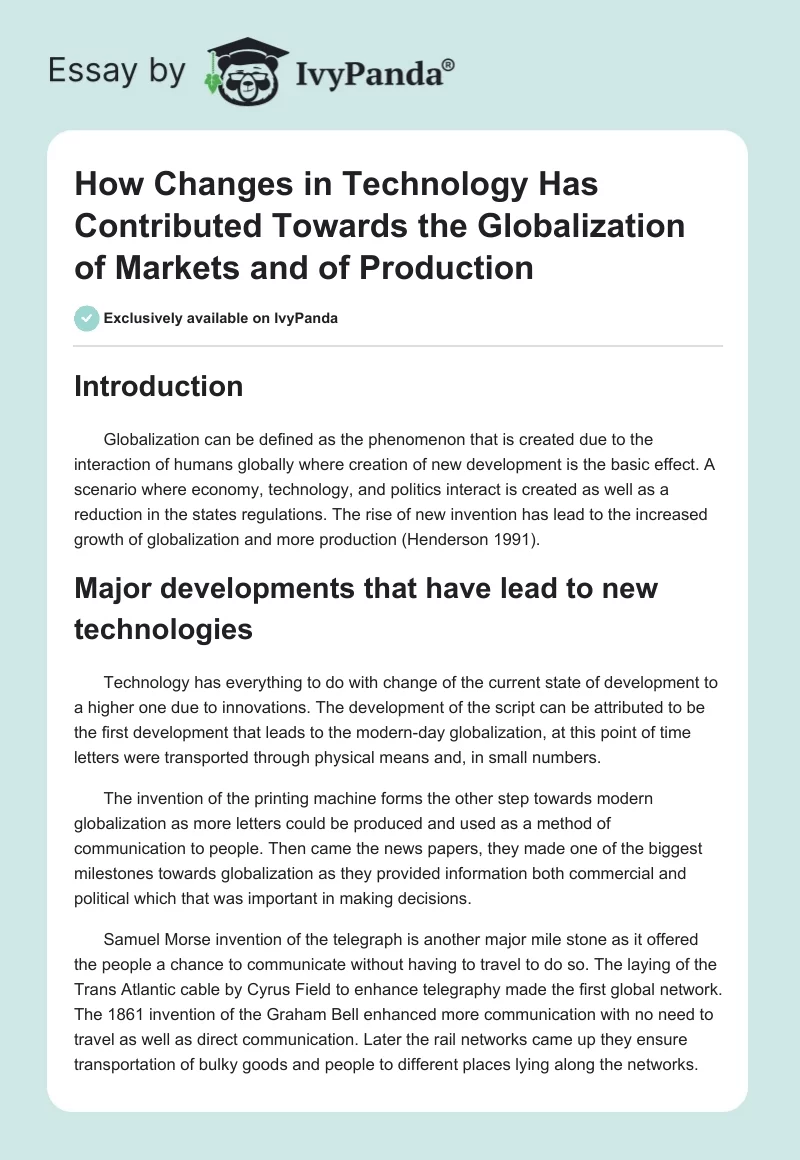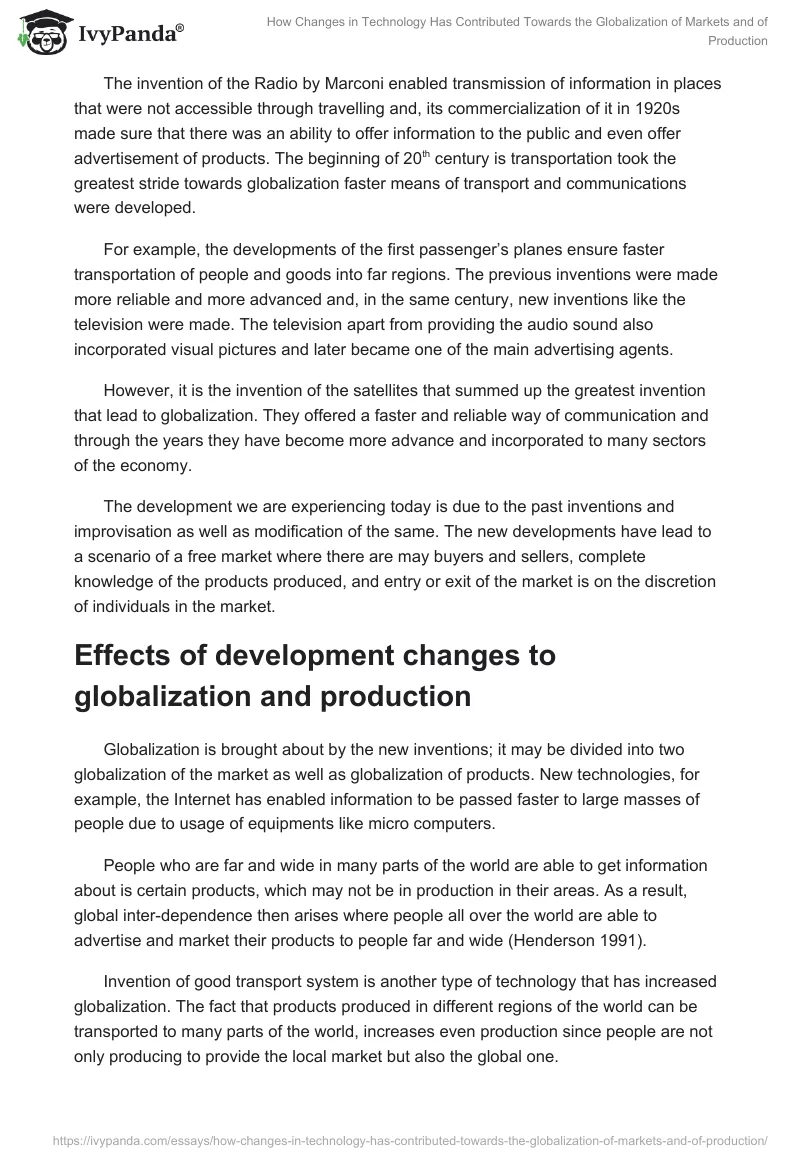Introduction
Globalization can be defined as the phenomenon that is created due to the interaction of humans globally where creation of new development is the basic effect. A scenario where economy, technology, and politics interact is created as well as a reduction in the states regulations. The rise of new invention has lead to the increased growth of globalization and more production (Henderson 1991).
Major developments that have lead to new technologies
Technology has everything to do with change of the current state of development to a higher one due to innovations. The development of the script can be attributed to be the first development that leads to the modern-day globalization, at this point of time letters were transported through physical means and, in small numbers.
The invention of the printing machine forms the other step towards modern globalization as more letters could be produced and used as a method of communication to people. Then came the news papers, they made one of the biggest milestones towards globalization as they provided information both commercial and political which that was important in making decisions.
Samuel Morse invention of the telegraph is another major mile stone as it offered the people a chance to communicate without having to travel to do so. The laying of the Trans Atlantic cable by Cyrus Field to enhance telegraphy made the first global network. The 1861 invention of the Graham Bell enhanced more communication with no need to travel as well as direct communication. Later the rail networks came up they ensure transportation of bulky goods and people to different places lying along the networks.
The invention of the Radio by Marconi enabled transmission of information in places that were not accessible through travelling and, its commercialization of it in 1920s made sure that there was an ability to offer information to the public and even offer advertisement of products. The beginning of 20th century is transportation took the greatest stride towards globalization faster means of transport and communications were developed.
For example, the developments of the first passenger’s planes ensure faster transportation of people and goods into far regions. The previous inventions were made more reliable and more advanced and, in the same century, new inventions like the television were made. The television apart from providing the audio sound also incorporated visual pictures and later became one of the main advertising agents.
However, it is the invention of the satellites that summed up the greatest invention that lead to globalization. They offered a faster and reliable way of communication and through the years they have become more advance and incorporated to many sectors of the economy.
The development we are experiencing today is due to the past inventions and improvisation as well as modification of the same. The new developments have lead to a scenario of a free market where there are may buyers and sellers, complete knowledge of the products produced, and entry or exit of the market is on the discretion of individuals in the market.
Effects of development changes to globalization and production
Globalization is brought about by the new inventions; it may be divided into two globalization of the market as well as globalization of products. New technologies, for example, the Internet has enabled information to be passed faster to large masses of people due to usage of equipments like micro computers.
People who are far and wide in many parts of the world are able to get information about is certain products, which may not be in production in their areas. As a result, global inter-dependence then arises where people all over the world are able to advertise and market their products to people far and wide (Henderson 1991).
Invention of good transport system is another type of technology that has increased globalization. The fact that products produced in different regions of the world can be transported to many parts of the world, increases even production since people are not only producing to provide the local market but also the global one.
Faster means of transport like electric train and airplanes ensures that the even perishable products like flowers from different parts can be transported far and wide without going bad. The issue of transport of perishable goods opens room to discuss technology used to transport them in transit.
Mega freezers that ensure that the products do not go bad for a considerable period of time ensure reliability to consumers that they will get their products in the desired state. Moreover, heavy products like incase of transportation of crude oil of bulky products is also possible through the transportation of consignment using ships or yatches. Customer’s tastes and preferences have also been met through the available inventions in technology as many products are now available in the market (Henderson 1991).
Financial markets as well as web based transaction has come to been common among many people as the introduction of micro computers has made it faster. Coming along as the substitute to traditional barter trade, it has brought about a different dimension in trading.
People with the will to trade in shares can do it online, and they do not have travel to do it. In America alone, the web transaction have increased from virtually zero in 1994 to $250 billion in 2007, in the United States alone on the other hand, the number of people using the Internet has moved from about 1million in1990s to about 1.3 billion in 2007. To add on that, money exchanges are also done online: therefore, people who want to make payment for their deliveries of transport can have so much ease In doing it (Hill 2000).
Globalization in markets has arisen due to change of technology and new ones coming along. By definition, globalization of markets can be defined as the formation of a huge market place due to merging of different, separate markets. The global market has developed in such a way that it offers the needs of each and every individual all over the world.
Multinational companies have arisen from the new global market, and they are offering their services in different parts of the world. For example, a company like Coca Cola is one of the beneficially companies of the global market as it offers its products in different parts of the world (Akhunov 2005).
Technology changes have lead to better ways of production. The new technologies have lead to globalization in production. By definition, globalization in production is taking advantages of the national differences between countries and enjoys cheap and quality resources through sourcing them in counties that they are cheaper.
The aims of the organizations are to lower the cost of production but still maintain the quality. Availability of the new technologies especially in the production industries produce massive product and due to the economies of scale reduce on their variable cost so that the total cost reduces. The companies eventually become very competitive in the market since they will automatically have lower their prices that organizations not embracing technology.
The quality achieved because of the new technologies is high and more products are produced. Boeing is one example of a company that produces products that enjoy a globalized production and, has a world-wide market of Boeing planes. Technology then goes a step ahead to inform the masses who is producing what, through online marketing products of many companies are now getting to be known all over the world (Akhunov 2005).
Conclusion
The establishment of the networks in different parts of the world has brought about interaction between many different cultures and people. The interaction between the various technologies used in various regions has lead to better technological developments. Ultimately development of a globalized market and production is the resultant.
The changes in the technologies that were previously used to the new ones has lead to the production and the market been globalized to the extent that product produced even in the farthest places in the world, are consumed by the global market the new technology has brought ease in both production and marketing of the products. Better machines have been invented for production which is faster, reliable, and more effective.
Separate markets have been joined together to form one major market that offers buyers and sellers to all produced market. With time, products that were produced using the previous technology are becoming exiting in the markets as the products produced with the new technology are relatively cheaper.
List of References
Akhunov A., Corsi. C. (2000). Innovation and market globalization: the position of SME’s. Amsterdam: IOS Press.
Henderson. J. (1991). The globalisation of high technology production: society, space and semiconductors in the restructuring of the modern world. London: Taylor & Francis.
Hill C. W. L. (2000). Global business today. New York: The McGraw-Hill Companies, Inc.


